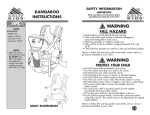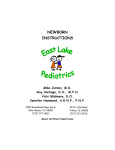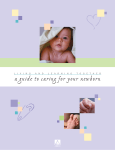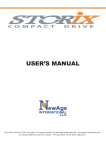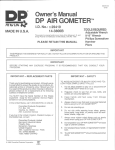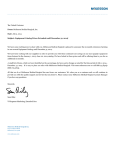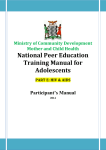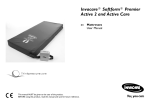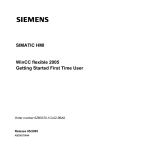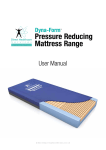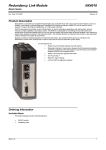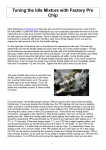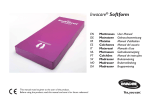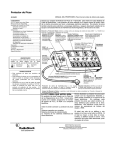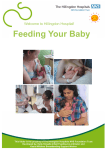Download Newborn Guide - Northside Cherokee Pediatrics
Transcript
Newborn Guide 684 Sixes Road, Suite 220 • Holly Springs, GA 30115 • p: (678) 388-5485 • f: (678) 388-5489 NEWBORN GUIDE Caring for your Baby Safety: Never leave your baby unattended, even for a minute, while bathing, changing, or in a car, stroller or shopping cart. Never accept a stranger’s offer to watch your baby, even if it would make the situation easier or more convenient for you. Consider the risk you may be taking when permitting your infant’s birth announcement to be published in the newspaper. Keep a color photograph of your infant (full, front-face view) as well as a complete written description including specific physical characteristics. It’s never too early to childproof your home. Accidents are common, especially for children 6-12 months of age. Look at your home and be aware of items and situations, which could be harmful. • NEVER SHAKE YOUR BABY. • Keep small objects like buttons or pins away from baby’s reach. • No one should be allowed to smoke in your home; exposing babies and children to any smoke is harmful. • Properly maintain your home smoke alarm and other detectors. • Do not hold your baby while cooking. Our MothersFirst program offers a Home Safety class that will teach you how to make your home a safe environment for infants and toddlers. For more information, or to register, please call 404-845-5555 and press "1". Safe Bedding Practices For Infants A Safe Sleeping Environment For Your Baby • Place baby on his/her back on a firm tight-fitting mattress in a crib that meets current safety • standards. • Remove pillows, quilts, comforters, sheepskins,pillow-like stuffed toys and other soft products from the crib. • Consider using a sleeper or other sleep clothing as an alternative to blankets, with no other covering. • If using a blanket, put baby with feet at the foot of the crib. Tuck a thin blanket around the crib mattress, reaching only as far as the baby’s chest. • Make sure your baby’s head remains uncovered during sleep. • Do not place baby on a waterbed, sofa, soft mattress, pillow or other soft surface. Car Seat Safety: Bring your car seat (and base, if applicable) along with the instruction manual to the hospital before discharge and adjust the straps to fit your baby. Your baby may be monitored for a drop in his heart rate or oxygen level while sitting upright in the car seat. Plan to attend this observation so that you are available to position or adjust your baby in the car seat. The purpose of this is to evaluate the infant sitting upright, not the safety of the car seat. If you would like to attend a MothersFirst Car Seat Safety class, please call 404-845-5555 and press "1". Please leave the car seat in the car on discharge day. Handwashing: This is the most important and basic way to control the spread of germs. Be sure to wash your handsbefore caring for your baby and after all diaper changes. Encourage everyone who comes in contact with your baby to wash their hands thoroughly. Bulb Syringe: Babies sometimes get stuffy noses. A stuffy nose without "running" is normal. The bulb syringe may beused to clear the nose. Your baby may not like the bulb syringe, and will not hesitate to express his feelings. Use the bulb syringe gently and only when necessary. Excessive use may irritate the mucus membranes, causing swelling and increasing the problems. How to use Bulb Syringe: If baby spits up: •Turn the head to the side •Squeeze bulb syringe to push the air out •Insert tip into cheek (do not insert into the throat - may cause gagging) •Release •Repeat if necessary Secretions from the nose can be removed in the same way by gently inserting the very tip into the nose. Do not force or squeeze air into the baby’s nose. Pacifier Use: All babies have a natural need to suck that goes beyond the sucking that occurs during feeding. This need can easily be confused with a need for more food. If your baby has been fed and is still sucking, you may wish to offer a pacifier. Do not overfeed your baby in an attempt to satisfy sucking. Never put a pacifier on a string around your baby’s neck. Bathing: Bath time can be a fun time and great opportunity for you and your baby to get to know each other. Don’t be afraid to handle your baby. During the bath, you can examine and play with your baby. Remember that your baby may cry while getting a bath. Until your baby’s umbilical cord and circumcision have completely healed, give only a sponge bath if necessary. Do not place your baby in the water, but soap and rinse him with a wash cloth while he remains on a bath towel. Establish a routine. Select a time when you are least likely to be interrupted. Do not bathe your baby right after a feeding. A daily bath is fine unless otherwise advised by your pediatrician. If not bathing daily, remember to clean the face and bottom each day. Use plain water on the face to avoid getting soap in the eyes. Bath Time: Choose a warm room that is free from drafts with the temperature slightly warmer than usual. Aconvenient place for bathing may be the bathroom or kitchen. Gather your supplies before you begin. You will need: 1. A basin/sink of warm water 2. Change of clothes and diaper 3. Wash cloths and towels 4. Soap - any mild soap such as a baby product or castile soap 5. Shampoo - if you are not using the bath soap 6. Comb/soft brush 7. Petroleum jelly and gauze squares for unhealed circumcision 8. Lotion - if desired. Do not use baby powder or baby oil. Sponge Bath: Once all your supplies are ready, test the water with your wrist or elbow - it should feel comfortably warm. Clean the eyes first. Wet the washcloth with plain water and wash from the inside to the outside corner of each eye. Next, use the tip of the washcloth to gently clean only what you can see in the ears and nose. Do not insert anything into the ears or nose. Wipe the face, neck and behind each ear with plain water and wash cloth. Pat dry. Undress your baby and bathe the body with soap and water starting from the neck and working down. Save the diaper area for last. Be sure to clean all folds and creases, but avoid getting the naval area wet. If your baby is a girl: Thick secretions may accumulate between the folds of her labia. Carefully and gently clean the area with moistened cotton balls or a wash cloth. What cannot be removed easily should be left alone. Always wipe your baby girl using a front to back motion. If your baby is a boy: If circumcised, no cleansing of the penis is necessary until the circumcision is healed, unless soiled with stool. Always carefully wash his scrotum, especially the underside after a bowel movement. If you choose not to have your son circumcised, check with your healthcare provider for a recommendation on care. Now rinse the entire body with clean water. Using a soft towel, gently pat dry paying attention to the folds and creases. You may shampoo your baby’s hair with each bath or every few days. Wrap your baby in a towel and, holding in the football position over the basin/sink, soap the scalp. Rinse the hair with clean water avoiding getting soap in the eyes. Now towel dry and comb the hair. You can apply a small amount of lotion to your hands and gently massage your baby. Use lotion sparingly to prevent a build up in the folds and creases. Tub Bath: Once your baby’s navel and circumcision have healed, substitute a small tub for the basin. The first few times you give a tub bath, use a small amount of water in the tub until your baby becomes used to being in the water. A towel or receiving blanket in the bottom of the tub will prevent your baby from slipping. Bathe your baby the same way as above. After your baby is all soaped, rinse gently and once out of the tub, pat dry. CAUTION: A wet, soapy baby is very slippery. NEVER leave your baby alone in the bath! Cord Care: Baby’s cord should be kept clean and dry. The cord stump will fall off in 7-14 days. A few drops of blood may appear before or after the cord falls off. Always fold the diaper below the cord stump until it falls off and the area looks like normal skin. If there is redness of the surrounding skin, drainage, foul odor or dampness, report these changes to your pediatrician. Never pull the cord stump off. Ask your pediatrician about cord cleaning preferences. Circumcision Care: Care for the "Gomco" circumcision includes placing Vaseline and gauze to the top of the penis until the area is healed (5-7 days). Change the gauze with every diaper change. A yellowish film on the head of the penis is normal and you should not attempt to clean it off. If a "Plastibell" is used, no extra care is required other than keeping the area clean. The "plastic bel" falls off in a week to 10 days. Diapering: Change your baby’s diaper as soon as possible after each bowel movement. Clean the diaper area with a wet cloth or diaper wipe each time you change the diaper. Remember to wipe baby girls from the front to the back. The diaper should fit snugly around the thighs and abdo- men to prevent leaking and should be folded below the umbilical cord until it is completely healed. Diaper your baby before, and if needed, after feeding. Diaper Rash: Babies have sensitive skin and may get a diaper rash at some time. When this occurs, change the diaper more often. Leaving a dirty diaper on too long causes redness and irritation. Leaving the diaper off or open for several hours will help the area heal. If the rash does not improve in 5-7 days, call your pediatrician. Elimination: Six to eight wet diapers a day are normal. Bowel movements- also called stools vary in consistency, color and frequency. Know your baby’s usual bowel pattern. the number of stools may vary from 6 - 8/ day to one every other day. Notify your pediatrician if your baby is having frequent watery stools, bloody stools or does not have a stool for three days. C o n s t i p a t i o n : Babies often grunt, strain or turn red in the face during normal bowel movements. Constipation is when the stools are small, firm and pebble-like. Call your pediatrician if your baby does not have a bowel movement for three days. Clothing: Dress your baby appropriately for the room or outside temperature. Keep the room temperature at your comfort. If your baby’s hands are cold or blotchy, add socks, hat, sweater or another blanket. If baby seems restless or fussy and the skin is flushed or reddened, remove a piece of clothing or blanket. You can take your baby’s temperature if you are concerned. Temperature: It is only necessary to take your baby’s temperature when he seems ill or hot or cold to the touch. Take your baby’s temperature either under the arm (axillary) or according to your Pediatricians instructions. Most Pediatricians do not recommend the use of ear thermometers in newborns. Take the temperature before you call the doctor. Always report the exact temperature and how it was taken. If your baby’s temperature is above 100 degrees F (axillary) or persistently below 97 degrees F (axillary), call the Pediatrician. A temperature greater than 100.4 F in an infant less than 3 months old is an emergency. Fingernails: The nails are soft and stick tightly to the skin under them. Until the nails harden, use an emery board to gently file the edges. Later on, you can use small, blunt- tipped scissors or baby clippers. Clip nails straight across while pressing the tip of the finger downward to avoid catching the skin. The best time to trim the nails is when your baby is quiet or asleep. If necessary, use mittens or sleepers with mitted hands. Behavior: It is very important that you care for your baby as much as possible during their hospitalization. This will help you get to know your baby. By the time of discharge, your baby should have developed a routine of eating and sleeping. To help your baby adjust to being home, for a while you may need to dim the lights, wrap your baby in a blanket, play soft music or keep the television on during the day. Development: Some things you can do to promote developmental skills in your baby include: 1) Tummy Time: Place your baby on his tummy when awake and alert to help strengthen the neck, back, arms and legs. Since your baby may be weak, you can try placing a rolled blanket under the arms while on the tummy to help lift the head. 2) Side lying: Place your baby side lying with back support, arms and hands forward to encourage hands to mouth and midline play. 3) Vision: Your baby will gradually spend more time awake. Work on visual skills by placing a toy 8-10 inches from the face and allow the eyes to focus on the toy. Babies tend to like red, white and black toys or toys that have stripes, checks or other patterns on them. Babies enjoy familiar faces so make eye contact and talk softly to your baby. A mobile over the crib is a wonderful way to work on your baby’s visual skills. Once your baby is able to look at a toy for a few minutes try moving the toys to the left, right, up and down. The baby should try to follow the toy with his eyes. 4) Speech and Hearing: Playing music and reading books to your baby will promote speech and language skills. When your baby is watching you, engage in "mouth play" such as sticking out your tongue, smiling, laughing and making sounds. Your baby will begin to imitate the noise in response, marking the beginning of conversation for your baby. 5) Hand Skills: Your baby will begin to use his hands to explore his environ ment. Babies like to explore their mouth, face and opposite hand. Hands together and at the mouth are comforting positions. Gradually they will begin to move their arms in response to toys and faces. Playing gentle games of pat-a- cake, peek-a-boo and assisting your baby to touch and grab toys will help your baby become aware of his hands. Feeding: Babies do not need cereal, juice or other baby foods until they are 4 to 6 months old. No additional water is needed. Breastmilk and formula supply all the water your baby needs. Do not give these foods to your baby until your doctor tells you to do so. Breastfeeding: Your baby may not seem like they are doing much at the first few breastfeedings. Sucking ablility will improve with practice and patience. Any attempt is considered a success. Rooting Reflex: After touching the center of the baby’s lip with the nipple, the baby will open its mouth, at which time the baby should be quickly latched on. Latching On: Baby is latched on wehn the mouth is wide open, lips rolled out and you see long jaw movement. Baby needs to be relatatched if you hear smacking sounds or the absence of swallowing sounds. To remove the baby, put your finger in the corner of the mouth to break the suction. Nursing Time: Allow the baby to nurse as long as they are sucking strongly and well latched. This is usually about 10-15 minutes of actual sucking time. Nurse frequently, every 2-3 hours during the first few weeks. A baby should nurse at least 8 times in a 24 hour period to establish a good milk supply. Atlernating Breasts: Baby may nurse only one side intitially, but try using both sides at each feeding. If both sides were used, it is best to begin the next feeding on the breast where the last feeding was completed. Some mothers place a safety pin on the bra strap of the side last nursed. Storage and Thawing: Storage Guidelines Fresh Breastmilk may be stored: •At room temperature for 5 hours •lIn the refrigerator for 5 days •In the freezer for 5 months Thawing Options: •Thaw in the refrigerator overnight •Thaw at room temperature 3-5 hours (thawing time determined by quantity frozen) •Thaw by gently shaking milk under warm running tap water Warning may by done by placing thawed breastmilk in a container of warm water and gently shaking. Water may need to be changed if it becomes cold before milk is warm. (Waming time determined by quantity). Use thawed breastmilk within 24 hours of thawing, BUT once the milk had been warmed or the infant has fed from the container, it must used within one hour. DO NOT MICROWAVE. Microwaves can heat unevenly and live cells in the breastmilk can be destroyed. Nutrition: Eat a well balanced diet and drink at least 5-8 glasses of fluid per day. The lacatation Center can provide you with a copy of nutrition tips if needed. Please call the Lactation Center Advice Line at 404.303.3329 if you have any questions. Bottle Feeding: Babies need an infant formula until they are one year of age. Formula comes in three forms: 1. Ready to Feed Liquid •Requires no additional water and little preparation time. •Requires refrigeration after opening. •Once opened, place in the refrigerator and use within 48 hours per manufacturer’s instructions. •Available in 8 and 32 ounce cans or disposable bottles in several sizes. •This is the most expensive type of formula. 2. Concentrated Liquid •Important to correctly mix formula with water as directed. •Requires refrigeration after opening. •Once opened, place in the refrigerator and use within 24 hour if mixed. Unmixed liquid concentrate should be used within 48 hours once opened. •This type of formula is in the middle price range. 3. Powdered •Important to correctly mix formula with water as directed. •nce mixed, place in the refrigerator and use within 24 hours •Opened powder can be used for up to one month. •Easy storage before and after can has been opened. •Convenient for travel or home use. •Available in one pound cans. •The least expensive type of formula. If the powder or concentrate or concentrate is used and mixed with tap water, no supplemental flouride is needed. Breastmilk, ready to feed and bottled, or well water, does not contain fluoride. Talk with your pediatrician if you have questions about fluoride. Sterilizing Bottles and Nipples: Check with your peditrician as to whether he/she feels this is necessary. Never prop a bottle. Always hold your baby during feedings. Avoid heating bottles in the microwave, the center can be scalding hot while the outside may feel cold. Warm bottles in warm water or use a bottle warmer. Be sure your baby’s head is not too far forward on the chest. Most babies feed for about 20 minutes. Feedings should not last longer than 30 minutes. Do not use a bottle that has been opened in room temperature for more than one hour. Burping: Your baby needs to be burped during feedings and again at the end to bring out any air that has been swallowed. If using the over-the-shoulder method, be sure the body is upright to allow the air to come up. You may also sit your baby on your lap supporting the head with your hand under the chin. Now lean the baby slightly forward as you gently pat or rub the back until any air has come up. Positioning: Studies have shown that positioning babies on their backs when sleeping decreases the risk of Sudden Infant Death Syndrome (SIDS). There is no evidence that sleeping on the back is harmful to infants. Certain infants may need to be placed in alternative positions for sleep. Please discuss your concerns with your pediatrician. Parenting Classes: A variety of parenting classes are available through our MothersFirst Program. If interested, please call 404-845-5555 and press “1” for more information or to reserve a class time. Metabolic Screen: This blood test is done on all babies. This is a screening test for metabolic errors and is required by law. The baby’s heel is pricked and a few drops of blood are collected. The results will be available to your pediatrician. Newborn Photographs: Hospital photographs are available for purchase. An informational brochure can be obtained at the reception desk for ordering and payment options. Before the day of discharge, you may bring a special outfit for you baby to wear for the photograph. Discharge Day: • The doctor must give permission for the baby to go home. • The Metabolic Screen must be completed. • Infants must have an appropriate car seat. Please install the car seat in your car and do NOT bring it to the bedside on discharge day. • You must have a pediatrician. It is a good idea to make an appointment to see your pediatrician before your baby is discharged. Most pediatricians would like to see your newborn in their office 2-3 days after you leave the hospital. Please notify your pediatrician if you have any problems or concerns after leaving the hospital. • Take the discharge folder with you to the first Pediatrician’s appointment. THE FIRST WEEK AT HOME: •Call your pediatrician if you have concerns about your infant after discharge from the hospital. •Realize the adjustment to a new environment is temporary. •Attempt to establish regular routines for bathing and playing. •Keep the crib simple and uncluttered. •Reduce the baby’s irritability by swaddling, placing on the back with a pacifier to suck on, or minimizing overall activity. •To help calm a fussy baby, hold your baby’s hands and feet together and be very still. •Learn to read and observe your baby’s cues for sleep and hunger. Notes














